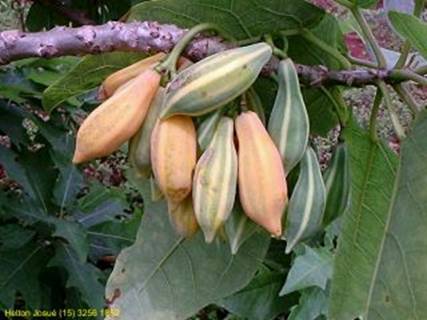Vasconcella (before carica) quercifolia
POPULAR NAMES: Iaracatiá, Mamaozinho do mato, Dwarf Forest Papaya
Caricaceae

INDIGENOUS NAME: Iaracatiá, comes from the Guarani and means "Pau of make sweet."
Origin: Forests of altitude of Atlantic Forest, from Minas Gerais to Rio Grande do Sul, Argentina, Paraguay and the Andes.
Characteristics:
It is a shrub of
Planted in the site of Frutas Raras: October 2002, bloomed for the first time in 2003, bear fruit in 2004.
Tips for
cultivation:
Plant of rapid growth,
appreciates
deep soils rich in
organic matter, resistant to low temperatures (to -3°C (27°F)), grows from
sea level up
Propagation: The
seeds are small and germinate in
Planting:
5 x 5 m (16 2/3 x 16 2/3
feet) of space between
trees, grows well in full sun and in shaded woods.
The holes must contain 40% organic matter and neutral pH, achieved with
the incorporation of
Cultivating: The
plant requires no pruning.The
fertilization with organic compost is sufficient, can be (
Uses: The sweet fruit, remembers the taste of papaya, can be eaten all with shell, but eat small amounts because of the laxative effect. Can also be used to make juices and sweets. The trunk is used to make a sweet similar to cocada.
Flowering in the site of Frutas Raras: October to February.
Fruiting in the site of Frutas Raras: January to April.
BUY THE BOOK “COLECIONANDO FRUTAS”
Back to the seedlist (English) or back to Caricaceae (Portuguese)